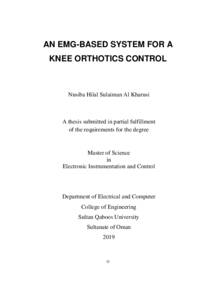Document
An EMG-based system for a knee orthotics control
Publisher
Sultan Qaboos University
Gregorian
2019
Language
English
Subject
English abstract
Legs are vital parts of the human body and are used for movement and standing. Many people around the world might lose their legs or lose the ability to walk normally due to accidents or diseases. Although there are many walking assistant devices available
clinically and commercially, such as prosthetics and orthotics, few are developed to be automated and safe. This situation motivated me to study this issue and develop an EMG- based automated knee-orthosis device. In the proposed method, an EMG signal was extracted from the motor neurons connected to the knee muscle while in movement. The extracted signal was then used to
drive a motor. The EMG signal was extracted using an EMG sensor placed on the upper knee muscle while the muscle was moving and the angle of the leg was recorded using an accelerometer placed on the lower limb below the knee. Both EMG and accelerometer
signals were then sent to a PC using MATLAB through a DAQ (Humsoft MF 624) for processing and control. In the first stage, these signals were pre-processed using a low- pass filter. Then, the relationship between the leg angle and EMG signal was estimated
using the MATLAB's System Identification Toolbox. This nonlinear relationship was modeled using a Hammerstein–Wiener model. This mapping was used to obtain the reference signal used in a closed-loop trajectory tracking control system. The proposed control system works as follows: 1) The EMG signal is measured from the upper knee muscle and transformed to an angle signal using the identified
nonlinear transform. 2) The transformed signal is low-pass filtered and used as a reference input of the closed-loop system to control a motor with a load. To assess the quality of the proposed EMG-based control system, the angle output of the servomotor was compared to the angle's signal measured from the real moving leg. This control system approach showed good matching between the two signals. Based on the obtained results, I expect that the proposed approach to be a better alternative to the widely used methods based on pattern recognition methods. The same approach was used to control a DC motor. To enhance the tracking capability of the proposed method, a PID controller was used for controlling the DC motor position. The performance of the proposed control method further compared to one of the standard EMG-based control method, namely the threshold-based method. The implementation results of both methods were compared by assessing the error between the real and desired leg angles.
Member of
Resource URL
Arabic abstract
من نعم الله الكثيرة على الإنسان أن جعل له القدمين يمشي بهما بسلاسة ، فيعمل ويسعى ويؤدي مهامه اليومية بشكل سهل ، الشلل أو المشي غير المتوازن هو أحد الأمراض التي تصيب البعض فيفقد يسببه قدرته على المشي كليا ، بينما يفقد آخرون المشي المتوازن ويحتاج البعض منهم إلى دعائم تساعدهم وتساندهم للمشي بسهولة ويسر بعض الأمراض التي تسبب الشلل تكون بسبب الجهاز العصبي أما البعض الآخر فتكون بسبب ضعف في العضلات.
تهدف هذه الدراسة إلى التحكم في محرك (يمثل الركبة) عن طريق كهربائية تخطيط العضل و التي تختصر بالرمز (EMG) ، تتولد هذه الإشارة عن طريق الدماغ و تنتقل في الجهاز العصبي حتى تصل إلى العضلة المسؤولة عن الحركة ، في هذه الدراسة يتم محاكاة حركة واحدة فقط عن طريق عضلة واحدة ، حيث يجلس متطوع على كرسي و يحرك رجله للأعلى و للأسفل و يتم محاكاة نفس الحركة في نفس الوقت ( real time) باستخدام محرك تيار مستمر .
وقد تم استخدام طريقتين للتحكم بمحرك التيار المستمر، الطريقة الأولى تعتمد على إيجاد العلاقة بين الإشارة العصبية من العضلة المسؤولة عن حركة الساق و زاوية الساق حيث يتم وضع مستشعر EMG على عضلة الركبة العليا ووضع مقياس تسارع على الساق أسفل الركبة لقياس زاوية الساق المتحركة. بعد ذلك يتم صياغة علاقة غير خطية بين الإشارتين السابقتين بواسطة برنامج الماتلاب عن طريق أداة في الماتلاب تدعى ب system identification toolbox باستخدام نموذج Hamrnerstein- Wiener في المرحلة الثانية يتم تسجيل إشارة الشبكة العصبية (EMG) عن طريق المتحسس و يتم إرسالها إلى الماتلاب حيث يتم ترشيح هذه الإشارات بمرشح منخفض التردد للحصول على إشارة أفضل ، وبعدها يتم تحويل هذه الإشارة عن طريق العلاقة غير الخطية إلى قيمة الزاوية المطلوبة و يتم استخدامها للتحكم بالمحرك ، ما الطريقة الثانية فهي من الطرق المنتشرة بشكل واسع ، و فيها يتم تقسيم إشارة الاشارة العصبية إلى عدة مستويات وفي كل مستوى يتم إرسال إشارة إلى المحرك ليتحرك بمقدار معين.
تهدف هذه الدراسة إلى التحكم في محرك (يمثل الركبة) عن طريق كهربائية تخطيط العضل و التي تختصر بالرمز (EMG) ، تتولد هذه الإشارة عن طريق الدماغ و تنتقل في الجهاز العصبي حتى تصل إلى العضلة المسؤولة عن الحركة ، في هذه الدراسة يتم محاكاة حركة واحدة فقط عن طريق عضلة واحدة ، حيث يجلس متطوع على كرسي و يحرك رجله للأعلى و للأسفل و يتم محاكاة نفس الحركة في نفس الوقت ( real time) باستخدام محرك تيار مستمر .
وقد تم استخدام طريقتين للتحكم بمحرك التيار المستمر، الطريقة الأولى تعتمد على إيجاد العلاقة بين الإشارة العصبية من العضلة المسؤولة عن حركة الساق و زاوية الساق حيث يتم وضع مستشعر EMG على عضلة الركبة العليا ووضع مقياس تسارع على الساق أسفل الركبة لقياس زاوية الساق المتحركة. بعد ذلك يتم صياغة علاقة غير خطية بين الإشارتين السابقتين بواسطة برنامج الماتلاب عن طريق أداة في الماتلاب تدعى ب system identification toolbox باستخدام نموذج Hamrnerstein- Wiener في المرحلة الثانية يتم تسجيل إشارة الشبكة العصبية (EMG) عن طريق المتحسس و يتم إرسالها إلى الماتلاب حيث يتم ترشيح هذه الإشارات بمرشح منخفض التردد للحصول على إشارة أفضل ، وبعدها يتم تحويل هذه الإشارة عن طريق العلاقة غير الخطية إلى قيمة الزاوية المطلوبة و يتم استخدامها للتحكم بالمحرك ، ما الطريقة الثانية فهي من الطرق المنتشرة بشكل واسع ، و فيها يتم تقسيم إشارة الاشارة العصبية إلى عدة مستويات وفي كل مستوى يتم إرسال إشارة إلى المحرك ليتحرك بمقدار معين.
Category
Theses and Dissertations

